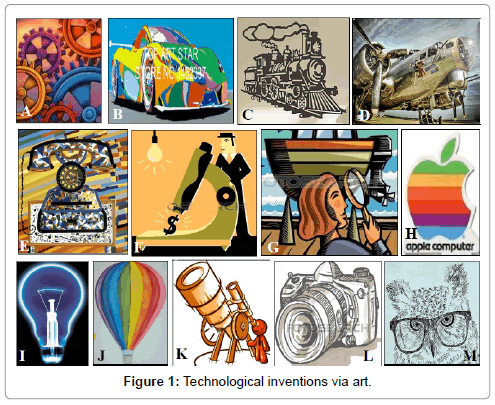Opinion Article Open Access
Technological Inventions via Art
Abraham Tamir*
Ben-Gurion University of the Negev, Israel.
- *Corresponding Author:
- Abraham Tamir
Emeritus Professor
Ben-Gurion University of the Negev
Israel
Tel: +972 8-646-1600
E-mail: atamir4@012.net.il
Received Date: June 14, 2016; Accepted Date: June 15, 2016; Published Date: June 17, 2016
Citation: Tamir A (2016) Technological Inventions via Art. J Civil Legal Sci 5:197. doi:10.4172/2169-0170.1000197
Copyright: © 2016 Tamir A. This is an open-access article distributed under the terms of the Creative Commons Attribution License, which permits unrestricted use, distribution, and reproduction in any medium, provided the original author and source are credited.
Visit for more related articles at Journal of Civil & Legal Sciences
Opinion Article
Invention is defined as a new and unexpected problem in the tangible world conceived in the mind of man. However the invention may also be a revolutionary invention that is not built from ideas that existed already. The first and the most important invention in human history was the invention of the wheel. Since then, wherever we look, our world revolves, literally, on wheels. At our home, at work, in our daily routine we use the wheels, ranging from leisure time we ride their bike or during work hours when we roll on the office chairs and until we ride by car wheels that drives us. The oldest wheel found to date is about 5500 years that was discovered in Mesopotamia, which are currently in Syria and Iraq. In a mural from more than five thousand years the wheel of this period is shown as curved wooden board that was used for transportation. Figure 1A depicts the shape of the wheel of about 4000 years ago. At the time, Thomas Alva Edison was considered as the largest and most famous inventor in the world that recorded a record number of 1,093 patents. The first invention that brought worldwide publicity to Edison was the “phonograph” in 1877 that was in fact the first practical device for recording and playback of sound. Later we will describe various technological inventions through works of art. Figure 1B is a drawing of a car, a motor vehicle designed to carry passengers or cargo, invented in 1886 by Karl Friedrich Benz. This car had three wheels and was driven by a motor with a single pulse. Figure 1C is a drawing of a train, ground transport vehicles used for transporting passengers and cargo. The train consisted of locomotive driven by a steam engine that drives the train carriages on railways. The steam engine was invented by Scottish sman James Watt in 1774. Figure 1D is a drawing of an airplane, motorized transport vehicles with wings used for passengers and cargo in air. On 17 December 1903 the Wright brothers first flew an airplane that was the fruit of their imagination. The plane was able to fly against the wind for 12 seconds over 37 meters. Figure 1E depicts the phone, an invention attributed to Alexander Graham Bell patented the device in 1876. Figure 1F depicts the microscope, a device used to visually enlarge small objects assembled first by the Dutch opticians Hans Jansen ad Zacarias. Figure 1G depicts amagnifying glass where Figure 1H is showing the work of Magritte of the first apple computer produces in 1976. Figure 1I is a drawing of a Incandescent developed in 1897 by German chemist and Nobel Laureate in Chemistry Walther. Figure 1J describes a balloon which is filled with hot air balloon or gas connected to the chamber for carrying passengers or cargo. The first balloon was built by the French brothers Joseph-Michel and Jacques-Etienne returned -1783 trying to manned flight. Figure 1K describes the telescope an instrument to view distant objects when the Dutchman Hans Lifrshii (1570-1619) is considered the inventor. Figure 1L describes the camera the basis of its developing was around the 5th century BC in which the Greeks described the principles of optics. In 1826 was invented the first camera filmed in black and white by the French inventor Nisfor Niifs. And finally outline Figure 1M, glasses; the most common means of improving the optical sight, an invention occurred in Italy during the second half of the 13th century.
--Relevant Topics
- Civil and Political Rights
- Common Law and Equity
- Conflict of Laws
- Constitutional Rights
- Corporate Law
- Criminal Law
- Cyber Law
- Human Rights Law
- Intellectual Property Law
- International public law
- Judicial Activism
- Jurisprudence
- Justice Studies
- Law
- Law and the Humanities
- Legal Philosophy
- Legal Rights
- Social and Cultural Rights
Recommended Journals
Article Tools
Article Usage
- Total views: 10885
- [From(publication date):
July-2016 - Apr 06, 2025] - Breakdown by view type
- HTML page views : 10054
- PDF downloads : 831

